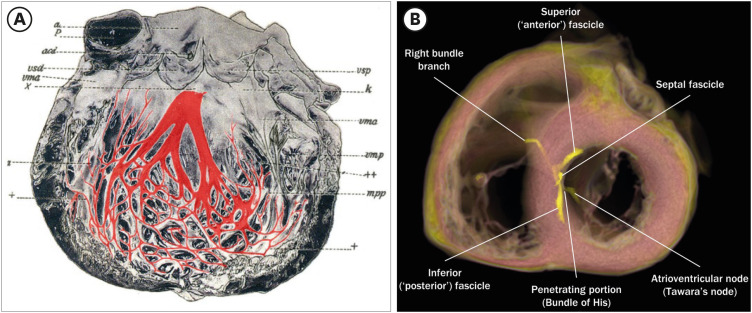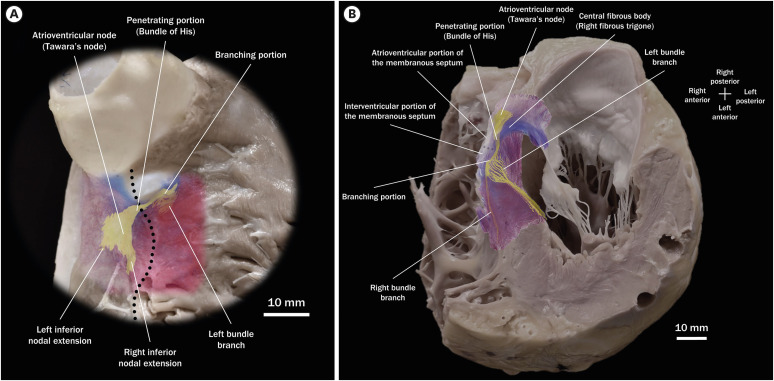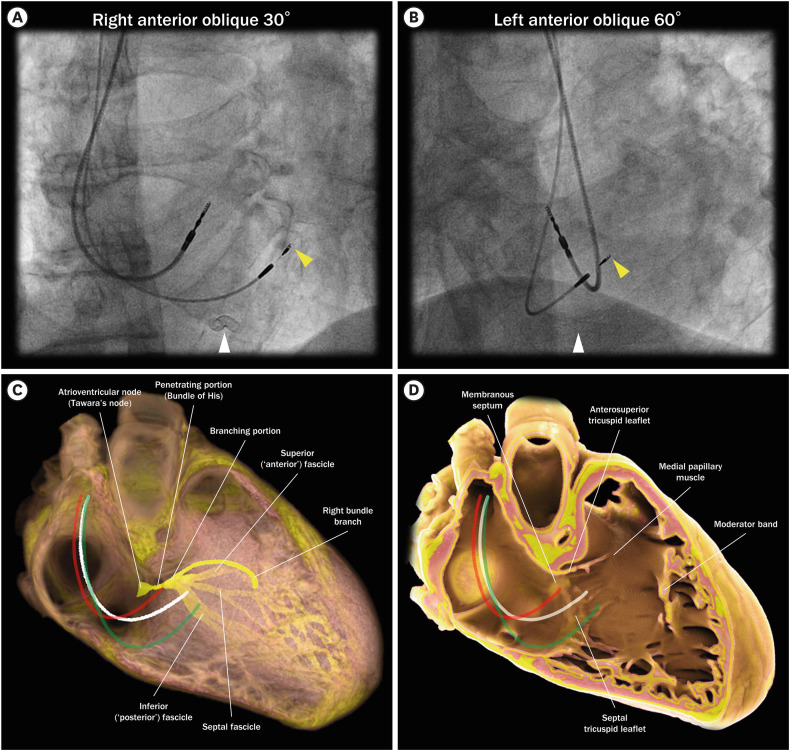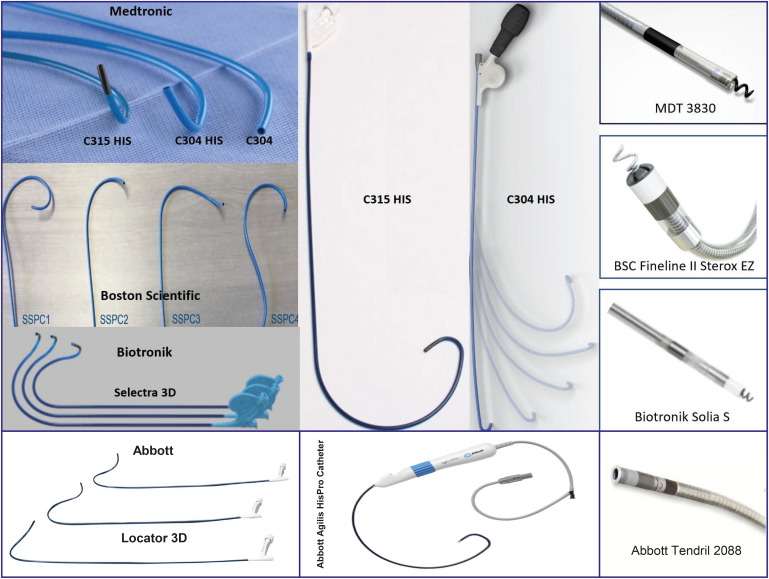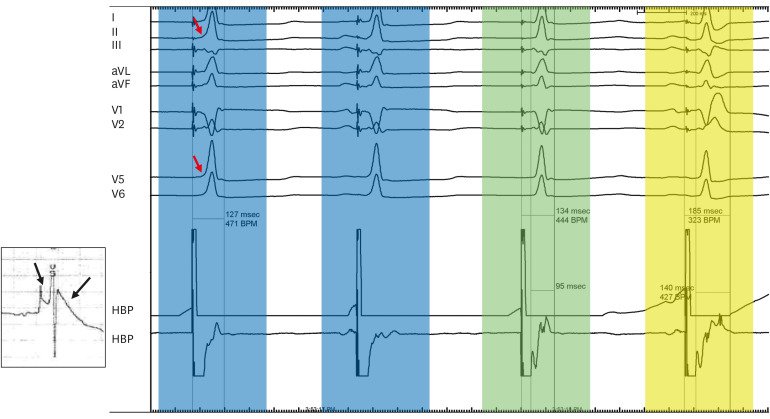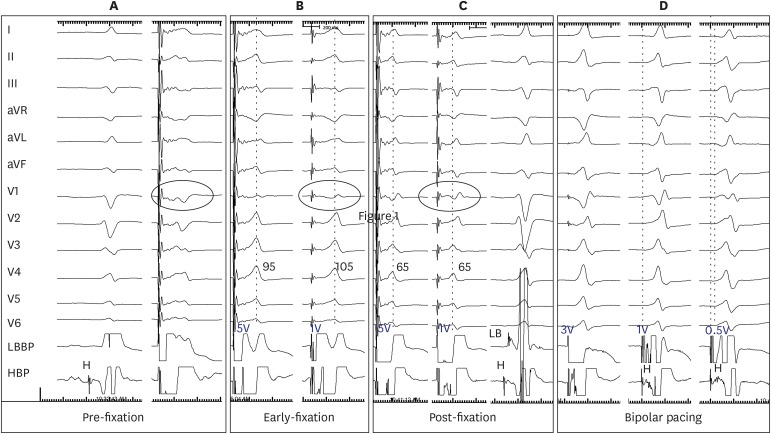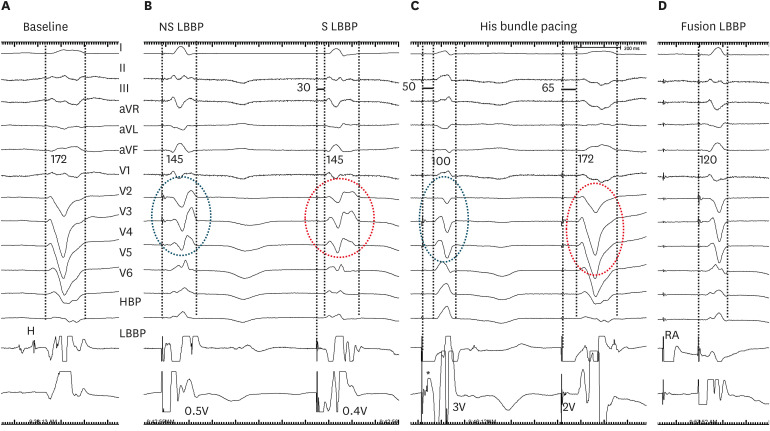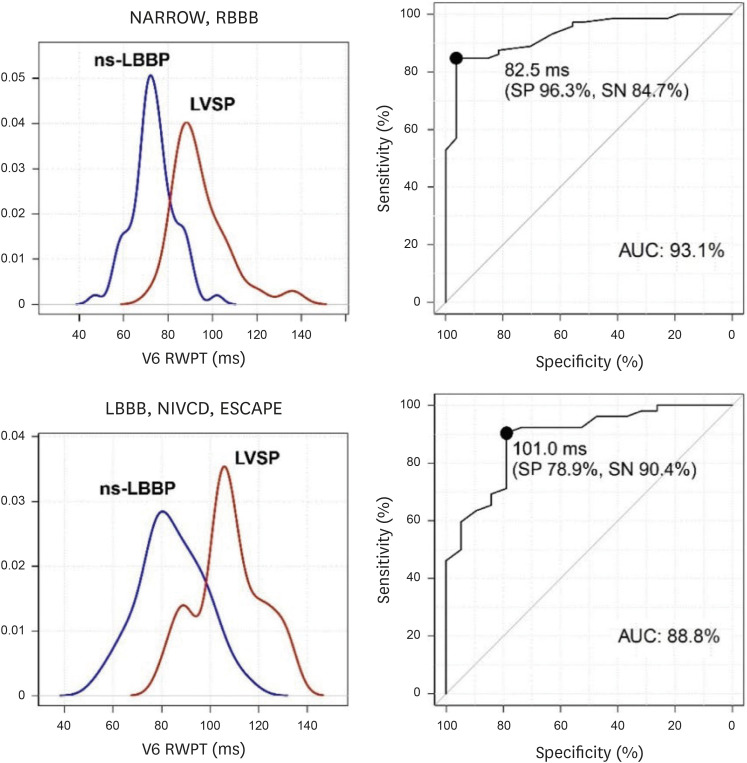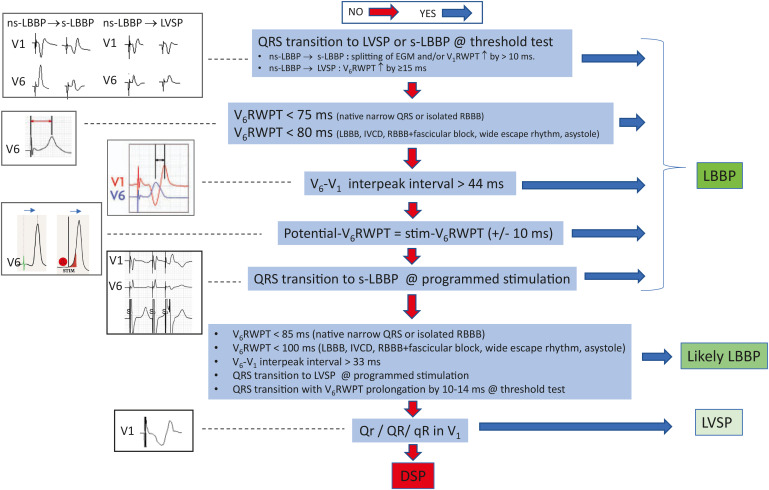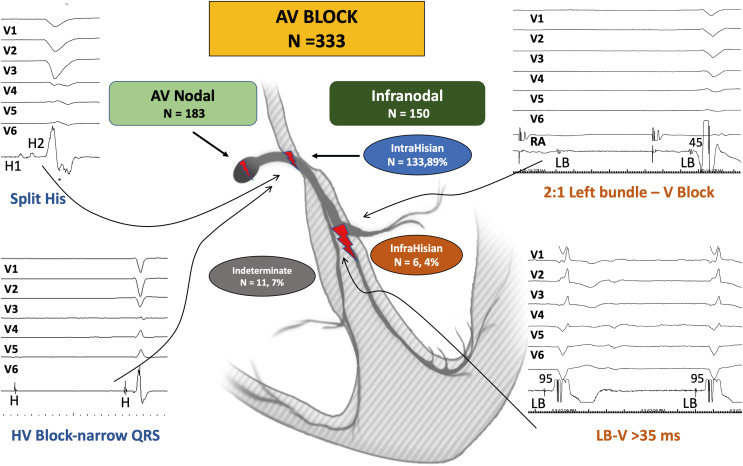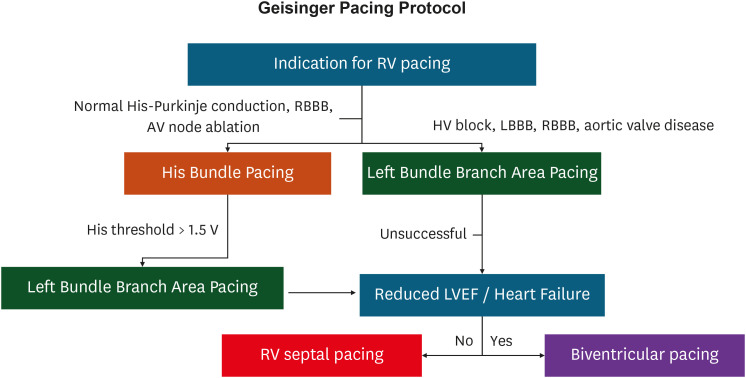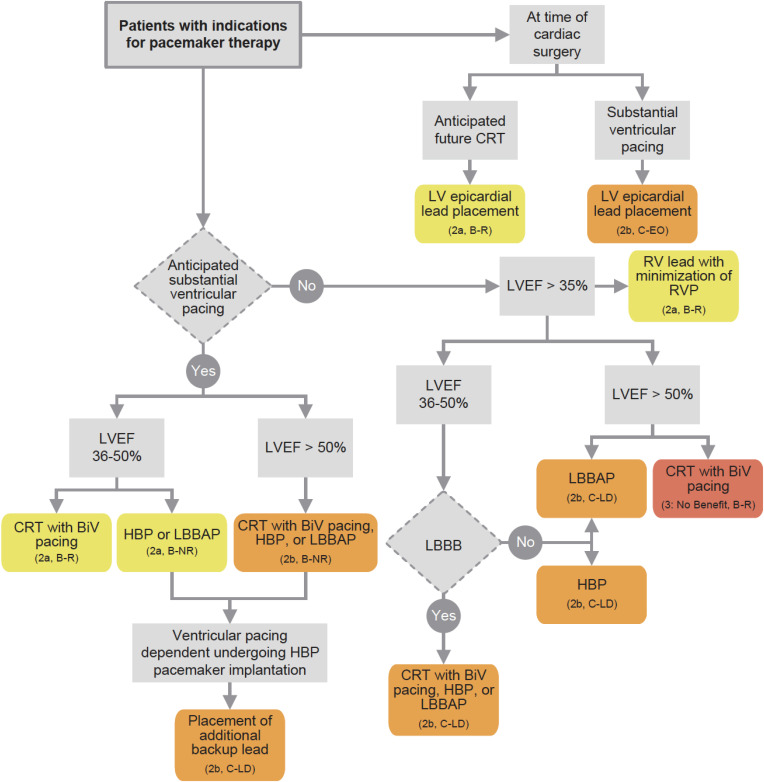Korean Circ J.
2024 Aug;54(8):427-453. 10.4070/kcj.2024.0113.
Current Role of Conduction System Pacing in Patients Requiring Permanent Pacing
- Affiliations
-
- 1Geisinger Heart Institute, Danville, PA, USA
- 2Geisinger Heart Institute, Wilkes-Barre, PA, USA
- KMID: 2558535
- DOI: http://doi.org/10.4070/kcj.2024.0113
Abstract
- His bundle pacing (HBP) and left bundle branch pacing (LBBP) are novel methods of pacing directly pacing the cardiac conduction system. HBP while developed more than two decades ago, only recently moved into the clinical mainstream. In contrast to conventional cardiac pacing, conduction system pacing including HBP and LBBP utilizes the native electrical system of the heart to rapidly disseminate the electrical impulse and generate a more synchronous ventricular contraction. Widespread adoption of conduction system pacing has resulted in a wealth of observational data, registries, and some early randomized controlled clinical trials. While much remains to be learned about conduction system pacing and its role in electrophysiology, data available thus far is very promising. In this review of conduction system pacing, the authors review the emergence of conduction system pacing and its contemporary role in patients requiring permanent cardiac pacing.
Keyword
Figure
Reference
-
1. Zhang XH, Chen H, Siu CW, et al. New-onset heart failure after permanent right ventricular apical pacing in patients with acquired high-grade atrioventricular block and normal left ventricular function. J Cardiovasc Electrophysiol. 2008; 19:136–141. PMID: 18005026.2. Kiehl EL, Makki T, Kumar R, et al. Incidence and predictors of right ventricular pacing-induced cardiomyopathy in patients with complete atrioventricular block and preserved left ventricular systolic function. Heart Rhythm. 2016; 13:2272–2278. PMID: 27855853.3. Sweeney MO, Hellkamp AS, Ellenbogen KA, et al. Adverse effect of ventricular pacing on heart failure and atrial fibrillation among patients with normal baseline QRS duration in a clinical trial of pacemaker therapy for sinus node dysfunction. Circulation. 2003; 107:2932–2937. PMID: 12782566.4. Ravi V, Beer D, Pietrasik GM, et al. Development of new‐onset or progressive atrial fibrillation in patients with permanent his bundle pacing versus right ventricular pacing: Results from the RUSH HBP registry. J Am Heart Assoc. 2020; 9:e018478. PMID: 33174509.5. Abraham WT, Fisher WG, Smith AL, et al. Cardiac resynchronization in chronic heart failure. N Engl J Med. 2002; 346:1845–1853. PMID: 12063368.6. Auricchio A, Stellbrink C, Block M, et al. Effect of pacing chamber and atrioventricular delay on acute systolic function of paced patients with congestive heart failure. Circulation. 1999; 99:2993–3001. PMID: 10368116.7. Kass DA. Cardiac resynchronization therapy. J Cardiovasc Electrophysiol. 2005; 16(Suppl 1):S35–S41. PMID: 16138884.8. Arnold AD, Shun-Shin MJ, Keene D, et al. His resynchronization versus biventricular pacing in patients with heart failure and left bundle branch block. J Am Coll Cardiol. 2018; 72:3112–3122. PMID: 30545450.9. Singh JP, Houser S, Heist EK, Ruskin JN. The coronary venous anatomy: a segmental approach to aid cardiac resynchronization therapy. J Am Coll Cardiol. 2005; 46:68–74. PMID: 15992638.10. Verhaert D, Grimm RA, Puntawangkoon C, et al. Long-term reverse remodeling with cardiac resynchronization therapy: results of extended echocardiographic follow-up. J Am Coll Cardiol. 2010; 55:1788–1795. PMID: 20413027.11. Suffoletto MS, Dohi K, Cannesson M, Saba S, Gorcsan J 3rd. Novel speckle-tracking radial strain from routine black-and-white echocardiographic images to quantify dyssynchrony and predict response to cardiac resynchronization therapy. Circulation. 2006; 113:960–968. PMID: 16476850.12. Randhawa A, Saini A, Aggarwal A, Rohit MK, Sahni D. Variance in coronary venous anatomy: a critical determinant in optimal candidate selection for cardiac resynchronization therapy. Pacing Clin Electrophysiol. 2013; 36:94–102. PMID: 23106173.13. Deshmukh P, Casavant DA, Romanyshyn M, Anderson K. Permanent, direct His-bundle pacing: a novel approach to cardiac pacing in patients with normal His-Purkinje activation. Circulation. 2000; 101:869–877. PMID: 10694526.14. Beer D, Dandamudi G, Mandrola JM, Friedman PA, Vijayaraman P. His-bundle pacing: impact of social media. Europace. 2019; 21:1445–1450. PMID: 31230085.15. Mabo P, Scherlag BJ, Munsif A, Otomo K, Lazzara R. A technique for stable His-bundle recording and pacing: electrophysiological and hemodynamic correlates. Pacing Clin Electrophysiol. 1995; 18:1894–1901. PMID: 8539158.16. Beer D, Sharma PS, Subzposh FA, et al. Clinical outcomes of selective versus nonselective his bundle pacing. JACC Clin Electrophysiol. 2019; 5:766–774. PMID: 31320004.17. Keene D, Arnold AD, Jastrzębski M, et al. His bundle pacing, learning curve, procedure characteristics, safety, and feasibility: Insights from a large international observational study. J Cardiovasc Electrophysiol. 2019; 30:1984–1993. PMID: 31310403.18. Vijayaraman P, Naperkowski A, Subzposh FA, et al. Permanent His-bundle pacing: Long-term lead performance and clinical outcomes. Heart Rhythm. 2018; 15:696–702. PMID: 29274474.19. Abdelrahman M, Subzposh FA, Beer D, et al. Clinical outcomes of his bundle pacing compared to right ventricular pacing. J Am Coll Cardiol. 2018; 71:2319–2330. PMID: 29535066.20. Huang W, Su L, Wu S, et al. A novel pacing strategy with low and stable output: pacing the left bundle branch immediately beyond the conduction block. Can J Cardiol. 2017; 33:1736.e1–1736.e3.21. Huang W, Chen X, Su L, Wu S, Xia X, Vijayaraman P. A beginner’s guide to permanent left bundle branch pacing. Heart Rhythm. 2019; 16:1791–1796. PMID: 31233818.22. Vazquez PM, Mohamed U, Zanon F, et al. Result of the Physiologic Pacing Registry, an international multicenter prospective observational study of conduction system pacing. Heart Rhythm. 2023; 20:1617–1625. PMID: 37348800.23. Cabrera JÁ, Porta-Sánchez A, Tung R, Sánchez-Quintana D. Tracking down the anatomy of the left bundle branch to optimize left bundle branch pacing. JACC Case Rep. 2020; 2:750–755. PMID: 34317341.24. Tawara S. Das Reizleitungssystem des Säugetierherzens: Eine Anatomisch-Histologische Studie über das Atrioventrikularbündel und die Purkinjeschen Fäden. Berlin: Fischer;1906.25. Jeffery NS, Stephenson RS, Gallagher JA, Jarvis JC, Cox PG. Micro-computed tomography with iodine staining resolves the arrangement of muscle fibres. J Biomech. 2011; 44:189–192. PMID: 20846653.26. Stephenson RS, Atkinson A, Kottas P, et al. High resolution 3-dimensional imaging of the human cardiac conduction system from microanatomy to mathematical modeling. Sci Rep. 2017; 7:7188. PMID: 28775383.27. Vijayaraman P, Chelu MG, Curila K, et al. Cardiac conduction system pacing: a comprehensive update. JACC Clin Electrophysiol. 2023; 9:2358–2387. PMID: 37589646.28. Sánchez-Quintana D, Anderson RH, Tretter JT, Cabrera JA, Sternick EB, Farré J. Anatomy of the conduction tissues 100 years on: what have we learned? Heart. 2021.29. Mori S, Hanna P, Bhatt RV, Shivkumar K. The atrioventricular bundle: a sesquicentennial tribute to professor sunao tawara. JACC Clin Electrophysiol. 2023; 9:444–447. PMID: 36752481.30. McAlpine WA. Heart and Coronary Arteries: An Anatomical Atlas for Clinical Diagnosis, Radiological Investigation, and Surgical Treatment. New York (NY): Springer Science & Business Media;2012.31. Ponnusamy SS, Vijayaraman P. How to implant His bundle and left bundle pacing leads: tips and pearls. Card Fail Rev. 2021; 7:e13. PMID: 34466272.32. Vijayaraman P, Subzposh FA, Naperkowski A, et al. Prospective evaluation of feasibility and electrophysiologic and echocardiographic characteristics of left bundle branch area pacing. Heart Rhythm. 2019; 16:1774–1782. PMID: 31136869.33. Vijayaraman P, Ponnusamy S, Cano Ó, et al. Left bundle branch area pacing for cardiac resynchronization therapy: results from the International LBBAP Collaborative Study Group. JACC Clin Electrophysiol. 2021; 7:135–147. PMID: 33602393.34. Vijayaraman P, Dandamudi G, Zanon F, et al. Permanent His bundle pacing: recommendations from a Multicenter His Bundle Pacing Collaborative Working Group for standardization of definitions, implant measurements, and follow-up. Heart Rhythm. 2018; 15:460–468. PMID: 29107697.35. Jastrzębski M, Kiełbasa G, Curila K, et al. Physiology-based electrocardiographic criteria for left bundle branch capture. Heart Rhythm. 2021; 18:935–943. PMID: 33677102.36. Jastrzębski M, Burri H, Kiełbasa G, et al. The V6-V1 interpeak interval: a novel criterion for the diagnosis of left bundle branch capture. Europace. 2022; 24:40–47. PMID: 34255038.37. Jastrzębski M. ECG and pacing criteria for differentiating conduction system pacing from myocardial pacing. Arrhythm Electrophysiol Rev. 2021; 10:172–180. PMID: 34777822.38. Chung MK, Patton KK, Lau CP, et al. 2023 HRS/APHRS/LAHRS guideline on cardiac physiologic pacing for the avoidance and mitigation of heart failure. Heart Rhythm. 2023; 20:e17–e91. PMID: 37283271.39. Burri H, Jastrzebski M, Cano Ó, et al. EHRA clinical consensus statement on conduction system pacing implantation: executive summary. Endorsed by the Asia-Pacific Heart Rhythm Society (APHRS), Canadian Heart Rhythm Society (CHRS) and Latin-American Heart Rhythm Society (LAHRS). Europace. 2023; 25:1237–1248. PMID: 37061850.40. Lustgarten DL, Calame S, Crespo EM, Calame J, Lobel R, Spector PS. Electrical resynchronization induced by direct His-bundle pacing. Heart Rhythm. 2010; 7:15–21. PMID: 19914142.41. El-Sherif N, Amay-Y-Leon F, Schonfield C, et al. Normalization of bundle branch block patterns by distal His bundle pacing. Clinical and experimental evidence of longitudinal dissociation in the pathologic his bundle. Circulation. 1978; 57:473–483. PMID: 624157.42. Upadhyay GA, Cherian T, Shatz DY, et al. Intracardiac delineation of septal conduction in left bundle-branch block patterns: mechanistic evidence of left intrahisian block circumvented by his bundle pacing. Circulation. 2019; 140:e713–e714. PMID: 31567009.43. Vijayaraman P, Naperkowski A, Ellenbogen KA, Dandamudi G. Electrophysiologic insights into site of atrioventricular block: lessons from permanent His bundle pacing. JACC Clin Electrophysiol. 2015; 1:571–581. PMID: 29759411.44. Vijayaraman P, Patel N, Colburn S, Beer D, Naperkowski A, Subzposh FA. His-Purkinje conduction system pacing in atrioventricular block: new insights into site of conduction block. JACC Clin Electrophysiol. 2022; 8:73–85. PMID: 34393084.45. Padala SK, Master VM, Terricabras M, et al. Initial experience, safety, and feasibility of left bundle branch area pacing: a multicenter prospective study. JACC Clin Electrophysiol. 2020; 6:1773–1782. PMID: 33357573.46. Su L, Wang S, Wu S, et al. Long-term safety and feasibility of left bundle branch pacing in a large single-center study. Circ Arrhythm Electrophysiol. 2021; 14:e009261. PMID: 33426907.47. Wang TJ, Larson MG, Levy D, et al. Temporal relations of atrial fibrillation and congestive heart failure and their joint influence on mortality: the Framingham Heart Study. Circulation. 2003; 107:2920–2925. PMID: 12771006.48. Maisel WH, Stevenson LW. Atrial fibrillation in heart failure: epidemiology, pathophysiology, and rationale for therapy. Am J Cardiol. 2003; 91:2D–8D.49. Fitzpatrick AP, Kourouyan HD, Siu A, et al. Quality of life and outcomes after radiofrequency His-bundle catheter ablation and permanent pacemaker implantation: impact of treatment in paroxysmal and established atrial fibrillation. Am Heart J. 1996; 131:499–507. PMID: 8604629.50. Lee SH, Chen SA, Tai CT, et al. Comparisons of quality of life and cardiac performance after complete atrioventricular junction ablation and atrioventricular junction modification in patients with medically refractory atrial fibrillation. J Am Coll Cardiol. 1998; 31:637–644. PMID: 9502647.51. Ozcan C, Jahangir A, Friedman PA, et al. Significant effects of atrioventricular node ablation and pacemaker implantation on left ventricular function and long-term survival in patients with atrial fibrillation and left ventricular dysfunction. Am J Cardiol. 2003; 92:33–37. PMID: 12842241.52. Manolis AG, Katsivas AG, Lazaris EE, Vassilopoulos CV, Louvros NE. Ventricular performance and quality of life in patients who underwent radiofrequency AV junction ablation and permanent pacemaker implantation due to medically refractory atrial tachyarrhythmias. J Interv Card Electrophysiol. 1998; 2:71–76. PMID: 9869999.53. Brignole M, Pentimalli F, Palmisano P, et al. AV junction ablation and cardiac resynchronization for patients with permanent atrial fibrillation and narrow QRS: the APAF-CRT mortality trial. Eur Heart J. 2021; 42:4731–4739. PMID: 34453840.54. Brignole M, Pokushalov E, Pentimalli F, et al. A randomized controlled trial of atrioventricular junction ablation and cardiac resynchronization therapy in patients with permanent atrial fibrillation and narrow QRS. Eur Heart J. 2018; 39:3999–4008. PMID: 30165479.55. Ploux S, Eschalier R, Whinnett ZI, et al. Electrical dyssynchrony induced by biventricular pacing: implications for patient selection and therapy improvement. Heart Rhythm. 2015; 12:782–791. PMID: 25546811.56. Palmisano P, Ziacchi M, Dell’Era G, et al. Ablate and pace: comparison of outcomes between conduction system pacing and biventricular pacing. Pacing Clin Electrophysiol. 2023; 46:1258–1268. PMID: 37665040.57. Deshmukh PM, Romanyshyn M. Direct His-bundle pacing: present and future. Pacing Clin Electrophysiol. 2004; 27:862–870. PMID: 15189517.58. Vijayaraman P, Subzposh FA, Naperkowski A. Atrioventricular node ablation and His bundle pacing. Europace. 2017; 19:iv10–iv16. PMID: 29220422.59. Huang W, Su L, Wu S, et al. Benefits of permanent His bundle pacing combined with atrioventricular node ablation in atrial fibrillation patients with heart failure with both preserved and reduced left ventricular ejection fraction. J Am Heart Assoc. 2017; 6:e005309. PMID: 28365568.60. Cai M, Wu S, Wang S, et al. Left bundle branch pacing postatrioventricular junction ablation for atrial fibrillation: propensity score matching with His bundle pacing. Circ Arrhythm Electrophysiol. 2022; 15:e010926. PMID: 36166683.61. Pillai A, Kolominsky J, Koneru JN, et al. Atrioventricular junction ablation in patients with conduction system pacing leads: a comparison of His-bundle vs left bundle branch area pacing leads. Heart Rhythm. 2022; 19:1116–1123. PMID: 35351624.62. Vijayaraman P, Hashimova N, Mathew AJ, Subzposh FA, Naperkowski A. Simultaneous conduction system pacing and atrioventricular node ablation via axillary vs femoral access. Heart Rhythm. 2022; 19:1019–1021. PMID: 35385717.63. Vijayaraman P, Mathew AJ, Naperkowski A, et al. Conduction system pacing versus conventional pacing in patients undergoing atrioventricular node ablation: Nonrandomized, on-treatment comparison. Heart Rhythm O2. 2022; 3:368–376. PMID: 36097467.64. Huang W, Wang S, Su L, et al. His-bundle pacing vs biventricular pacing following atrioventricular nodal ablation in patients with atrial fibrillation and reduced ejection fraction: a multicenter, randomized, crossover study-The ALTERNATIVE-AF trial. Heart Rhythm. 2022; 19:1948–1955. PMID: 35843465.65. Chung MK, Patton KK, Lau CP, et al. 2023 HRS/APHRS/LAHRS guideline on cardiac physiologic pacing for the avoidance and mitigation of heart failure. J Arrhythm. 2023; 39:681–756. PMID: 37799799.66. Mahajan A, Trivedi R, Subzposh FA, Vijayaraman P. Feasibility of His bundle pacing and atrioventricular junction ablation with left bundle branch area pacing as backup. Heart Rhythm. 2024.67. Salden FC, Luermans JG, Westra SW, et al. Short-term hemodynamic and electrophysiological effects of cardiac resynchronization by left ventricular septal pacing. J Am Coll Cardiol. 2020; 75:347–359. PMID: 32000945.68. Blanc JJ, Etienne Y, Gilard M, et al. Evaluation of different ventricular pacing sites in patients with severe heart failure: results of an acute hemodynamic study. Circulation. 1997; 96:3273–3277. PMID: 9396415.69. Miyazawa AA, Francis DP, Whinnett ZI. Basic principles of hemodynamics in pacing. Card Electrophysiol Clin. 2022; 14:133–140. PMID: 35715072.70. Keene D, Shun-Shin MJ, Arnold AD, et al. Within-patient comparison of His-bundle pacing, right ventricular pacing, and right ventricular pacing avoidance algorithms in patients with PR prolongation: acute hemodynamic study. J Cardiovasc Electrophysiol. 2020; 31:2964–2974. PMID: 32976636.71. Zanon F, Bacchiega E, Rampin L, et al. Direct His bundle pacing preserves coronary perfusion compared with right ventricular apical pacing: a prospective, cross-over mid-term study. Europace. 2008; 10:580–587. PMID: 18407969.72. Arnold AD, Shun-Shin MJ, Ali N, et al. Contributions of atrioventricular delay shortening and ventricular resynchronization to hemodynamic benefits of biventricular pacing. JACC Clin Electrophysiol. 2023; 9:117–119. PMID: 36697190.73. Liang Y, Wang J, Gong X, et al. Left bundle branch pacing versus biventricular pacing for acute cardiac resynchronization in patients with heart failure. Circ Arrhythm Electrophysiol. 2022; 15:e011181. PMID: 36306335.74. Ali N, Arnold AD, Miyazawa AA, et al. Comparison of methods for delivering cardiac resynchronization therapy: an acute electrical and haemodynamic within-patient comparison of left bundle branch area, His bundle, and biventricular pacing. Europace. 2023; 25:1060–1067. PMID: 36734205.75. Zweerink A, Zubarev S, Bakelants E, et al. His-optimized cardiac resynchronization therapy with ventricular fusion pacing for electrical resynchronization in heart failure. JACC Clin Electrophysiol. 2021; 7:881–892. PMID: 33640346.76. Sharma PS, Dandamudi G, Naperkowski A, et al. Permanent His-bundle pacing is feasible, safe, and superior to right ventricular pacing in routine clinical practice. Heart Rhythm. 2015; 12:305–312. PMID: 25446158.77. Kronborg MB, Mortensen PT, Poulsen SH, Gerdes JC, Jensen HK, Nielsen JC. His or para-His pacing preserves left ventricular function in atrioventricular block: a double-blind, randomized, crossover study. Europace. 2014; 16:1189–1196. PMID: 24509688.78. Sharma PS, Patel NR, Ravi V, et al. Clinical outcomes of left bundle branch area pacing compared to right ventricular pacing: results from the Geisinger-Rush Conduction System Pacing Registry. Heart Rhythm. 2022; 19:3–11. PMID: 34481985.79. Vijayaraman P, Rajakumar C, Naperkowski AM, Subzposh FA. Clinical outcomes of left bundle branch area pacing compared to His bundle pacing. J Cardiovasc Electrophysiol. 2022; 33:1234–1243. PMID: 35488749.80. Tan ES, Soh R, Lee JY, et al. Clinical outcomes in conduction system pacing compared to right ventricular pacing in bradycardia. JACC Clin Electrophysiol. 2023; 9:992–1001. PMID: 36752453.81. Pastore G, Zanon F, Baracca E, et al. The risk of atrial fibrillation during right ventricular pacing. Europace. 2016; 18:353–358. PMID: 26443444.82. Ravi V, Sharma PS, Patel NR, et al. New-onset atrial fibrillation in left bundle branch area pacing compared with right ventricular pacing. Circ Arrhythm Electrophysiol. 2022; 15:e010710. PMID: 35333096.83. Li Y, Chen K, Dai Y, et al. Left bundle branch pacing for symptomatic bradycardia: Implant success rate, safety, and pacing characteristics. Heart Rhythm. 2019; 16:1758–1765. PMID: 31125667.84. Hou X, Qian Z, Wang Y, et al. Feasibility and cardiac synchrony of permanent left bundle branch pacing through the interventricular septum. Europace. 2019; 21:1694–1702. PMID: 31322651.85. Wang J, Liang Y, Wang W, et al. Left bundle branch area pacing is superior to right ventricular septum pacing concerning depolarization-repolarization reserve. J Cardiovasc Electrophysiol. 2020; 31:313–322. PMID: 31778249.86. Jastrzębski M, Moskal P, Bednarek A, et al. Programmed deep septal stimulation: a novel maneuver for the diagnosis of left bundle branch capture during permanent pacing. J Cardiovasc Electrophysiol. 2020; 31:485–493. PMID: 31930753.87. Chen X, Jin Q, Bai J, et al. The feasibility and safety of left bundle branch pacing vs. right ventricular pacing after mid-long-term follow-up: a single-centre experience. Europace. 2020; 22:ii36–ii44. PMID: 33370799.88. Su L, Xu T, Cai M, et al. Electrophysiological characteristics and clinical values of left bundle branch current of injury in left bundle branch pacing. J Cardiovasc Electrophysiol. 2020; 31:834–842. PMID: 32009260.89. Ponnusamy SS, Muthu G, Kumar M, Bopanna D, Anand V, Kumar S. Mid-term feasibility, safety and outcomes of left bundle branch pacing-single center experience. J Interv Card Electrophysiol. 2021; 60:337–346. PMID: 32623624.90. Zanon F, Abdelrahman M, Marcantoni L, et al. Long term performance and safety of His bundle pacing: a multicenter experience. J Cardiovasc Electrophysiol. 2019; 30:1594–1601. PMID: 31310410.91. Jastrzębski M, Kiełbasa G, Cano O, et al. Left bundle branch area pacing outcomes: the multicentre European MELOS study. Eur Heart J. 2022; 43:4161–4173. PMID: 35979843.92. Vijayaraman P, Zalavadia D, Haseeb A, et al. Clinical outcomes of conduction system pacing compared to biventricular pacing in patients requiring cardiac resynchronization therapy. Heart Rhythm. 2022; 19:1263–1271. PMID: 35500791.93. Wu S, Su L, Vijayaraman P, et al. Left bundle branch pacing for cardiac resynchronization therapy: nonrandomized on-treatment comparison with his bundle pacing and biventricular pacing. Can J Cardiol. 2021; 37:319–328. PMID: 32387225.94. Wang Y, Zhu H, Hou X, et al. Randomized trial of left bundle branch vs biventricular pacing for cardiac resynchronization therapy. J Am Coll Cardiol. 2022; 80:1205–1216. PMID: 36137670.95. Vinther M, Risum N, Svendsen JH, Møgelvang R, Philbert BT. A randomized trial of His pacing versus biventricular pacing in symptomatic HF patients with left bundle branch block (His-alternative). JACC Clin Electrophysiol. 2021; 7:1422–1432. PMID: 34167929.96. Upadhyay GA, Vijayaraman P, Nayak HM, et al. His corrective pacing or biventricular pacing for cardiac resynchronization in heart failure. J Am Coll Cardiol. 2019; 74:157–159. PMID: 31078637.97. Cano Ó, Vijayaraman P. Left bundle branch area pacing: Implant technique, definitions, outcomes, and complications. Curr Cardiol Rep. 2021; 23:155. PMID: 34599430.98. Wu S, Chen X, Wang S, et al. Evaluation of the criteria to distinguish left bundle branch pacing from left ventricular septal pacing. JACC Clin Electrophysiol. 2021; 7:1166–1177. PMID: 33933414.
- Full Text Links
- Actions
-
Cited
- CITED
-
- Close
- Share
- Similar articles
-
- Ventricular dyssynchrony in patients with permanent pacemaker
- A Case of Pacemaker Syndrome
- Reversal of Pacing-Induced Cardiomyopathy by Normal QRS Axis Pacing
- Long-term Follow-up of the Patients with Permanent Antibradycardia Pacemaker
- The Changes in Pacing Threshold of Permanent Endocardial Ventricular Pacemaker

